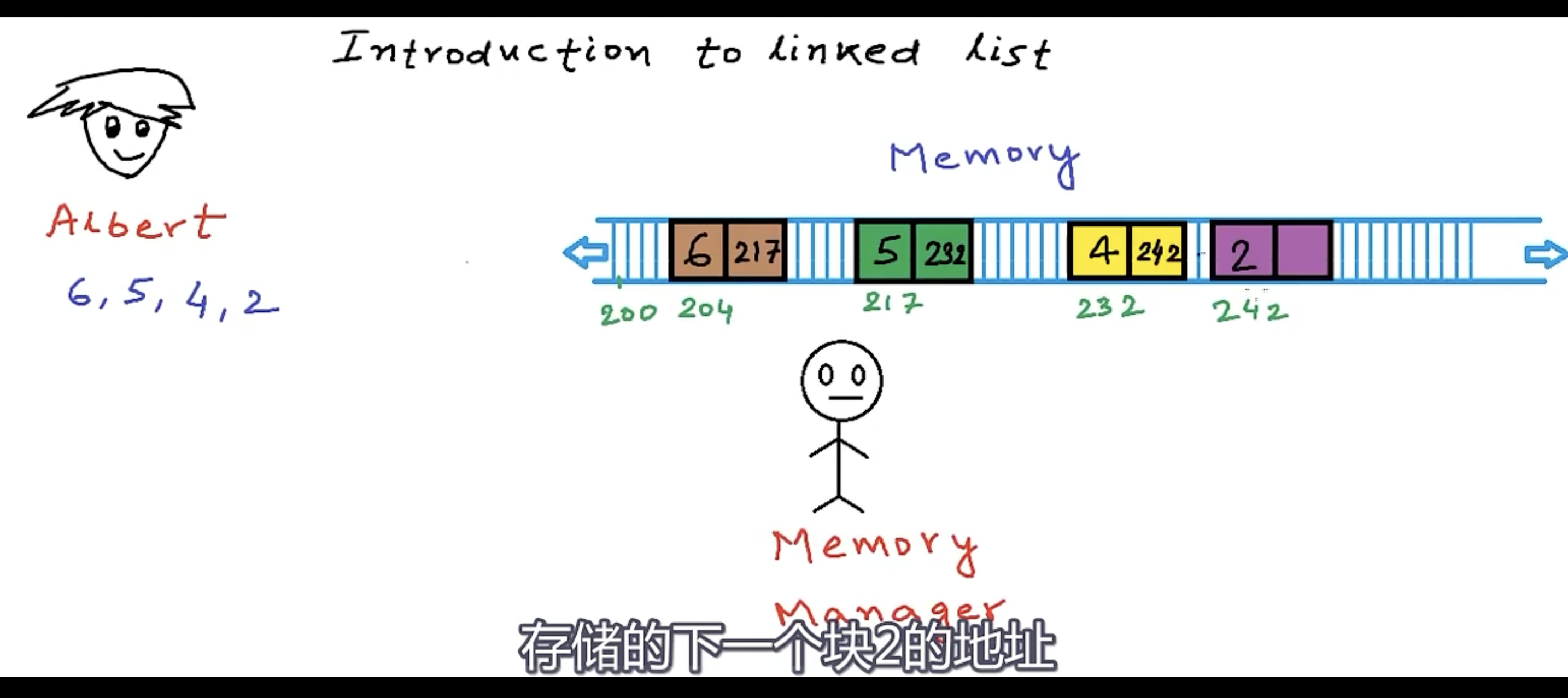线性表
链表
与数组不同的是,组成链表的格子不是连续的。它们可以分布在内存的各个地方。这种不相邻的格子,就叫作结点。每个结点除了保存数据,它还保存着链表里的下一结点的内存地址。如下图所示:

若想使用链表,只需知道第一个结点在内存的什么位置。因为每个结点都有指向下一结点的链,所以只要有给定的第一个结点,就可以用结点1的链找到结点2再用结点2的链找到结点3……如此遍历链表的剩余部分。下面这张图感觉更能形象的表述出这份意思

下面给出链表结构的C++代码实现部分
#include <iostream>
using namespace std;
class Node {
public:
int data;
Node* next;
Node(int data) {
this->data = data;
this->next = NULL;
}
};
class LinkedList {
public:
Node* head;
LinkedList() {
this->head = NULL;
}
void append(int data) {
Node* new_node = new Node(data);
if (this->head == NULL) {
this->head = new_node;
} else {
Node* current = this->head;
while (current->next != NULL) {
current = current->next;
}
current->next = new_node;
}
}
void insert(int data, int index) {
Node* new_node = new Node(data);
if (index == 0) {
new_node->next = this->head;
this->head = new_node;
} else {
Node* current = this->head;
for (int i = 0; i < index-1; i++) {
if (current == NULL) {
cout << "Error: Index out of range." << endl;
return;
}
current = current->next;
}
new_node->next = current->next;
current->next = new_node;
}
}
void remove(int index) {
if (this->head == NULL) {
cout << "Error: List is empty." << endl;
return;
}
if (index == 0) {
Node* temp = this->head;
this->head = this->head->next;
delete temp;
} else {
Node* current = this->head;
for (int i = 0; i < index-1; i++) {
if (current == NULL) {
cout << "Error: Index out of range." << endl;
return;
}
current = current->next;
}
if (current->next == NULL) {
cout << "Error: Index out of range." << endl;
return;
}
Node* temp = current->next;
current->next = temp->next;
delete temp;
}
}
void display() {
Node* current = this->head;
while (current != NULL) {
cout << current->data << " ";
current = current->next;
}
cout << endl;
}
};
int main() {
LinkedList list;
list.append(1);
list.append(2);
list.append(3);
list.display();
list.insert(4, 1);
list.display();
list.remove(2);
list.display();
return 0;
}
|
链表典型应用
单向链表通常用于实现栈、队列、哈希表和图等数据结构。
栈与队列:当插入和删除操作都在链表的一端进行时,它表现出先进后出的特性,对应栈;当插入操作在链表的一端进行,删除操作在链表的另一端进行,它表现出先进先出的特性,对应队列。
哈希表:链式地址是解决哈希冲突的主流方案之一,在该方案中,所有冲突的元素都会被放到一个链表中。
图:邻接表是表示图的一种常用方式,其中图的每个顶点都与一个链表相关联,链表中的每个元素都代表与该顶点相连的其他顶点。
双向链表常用于需要快速查找前一个和后一个元素的场景。
高级数据结构:比如在红黑树、B 树中,我们需要访问节点的父节点,这可以通过在节点中保存一个指向父节点的引用来实现,类似于双向链表。
浏览器历史:在网页浏览器中,当用户点击前进或后退按钮时,浏览器需要知道用户访问过的前一个和后一个网页。双向链表的特性使得这种操作变得简单。
LRU 算法:在缓存淘汰(LRU)算法中,我们需要快速找到最近最少使用的数据,以及支持快速添加和删除节点。这时候使用双向链表就非常合适。
环形链表常用于需要周期性操作的场景,比如操作系统的资源调度。
时间片轮转调度算法:在操作系统中,时间片轮转调度算法是一种常见的 CPU 调度算法,它需要对一组进程进行循环。每个进程被赋予一个时间片,当时间片用完时,CPU 将切换到下一个进程。这种循环操作可以通过环形链表来实现。
数据缓冲区:在某些数据缓冲区的实现中,也可能会使用环形链表。比如在音频、视频播放器中,数据流可能会被分成多个缓冲块并放入一个环形链表,以便实现无缝播放。
参考
1, 《数据结构与算法图解》 — 杰伊 温格罗著, 袁志鹏译
2, 《数据结构(C++语言版)》 — 邓俊辉 编著
3, Hello 算法


